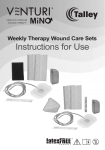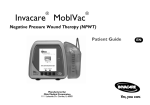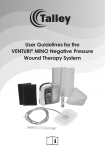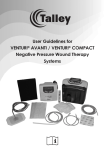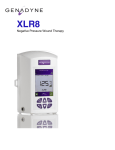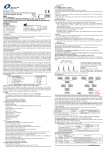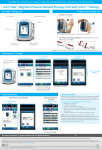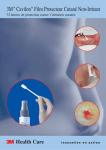Download Portal Drain Wound Care Set user leaflet
Transcript
EN Foam Wound Care Sets - Contents: PT NO SV DA FI NL IT ES DE FR Dressing Film, Measuring Tape Gauze Wound Care Sets - Contents: Portal Drain, Gauze, Saline, Transparent Wound Dressing Film, Measuring Tape Please check each Wound Care Set component before use. Do not use sterile items if packaging is damaged or unsealed. Do not use components past their expiry date. INDICATIONS FOR USE Use of the VENTURI® NPWT systems is indicated for use for patients with acute or chronic wounds. Wounds that may benefit from the application of negative pressure therapy include:- Partial/ Full thickness Pressure Ulcers; Dehisced surgical wounds; Diabetic/Neuropathic ulcers; Venous leg ulcers; Post surgical wounds; Sinus drainage and management; Traumatic wounds; Preop flap/graft; Post op surgical flap/grafts; Necrotising fasciitis; Burns CONTRAINDICATIONS FOR USE Do not place NPWT dressings directly in contact with exposed blood vessels, anastomotic sites, organs or nerves. NPWT is contraindicated for patients with:- Malignancy in the wound; Untreated osteomyelitis; Non-enteric and unexplored fistulas; Wounds with difficult haemostasis; Necrotic tissue with eschar present NOTE: After debridement of necrotic tissue and complete removal of eschar, NPWT can be used. Please refer to the VENTURI® NPWT Systems User Manual for detailed power unit operation instructions and to the VENTURI® Clinical Guidelines Manual for further information on application of Wound Care Sets and other clinical advice and safety information. Application Instructions CAUTION! The medical professional is responsible for using his/her best medical judgement when using this kit. Prior to use, the medical professional(s) treating the wound must assess how to best use the kit for an individual wound. 1. If required, irrigate the wound bed thoroughly with approximately 20ml of normal saline. Ensure surrounding wound edges are dry. 2. Prepare the periwound area if required by applying a liquid barrier film. For patients with fragile or excoriated periwound tissue, a protective thin layered dressing, thin hydrocolloid, or a vapour permeable adhesive film, may be applied to the periwound area. 3. If required, apply non-adherent wound contact layer as per local protocol to the wound surface, ensuring that the edges of this non-adherent are within the wound margins. CZ PL TR EL 4. RO Portal Drain, Foam Pad, Transparent Wound If using foam: Measure the wound dimensions, length, breadth and depth, and cut the foam to these dimensions to allow it to be placed gently into the wound. Once cut gently rub the foam edges to remove any loose pieces of foam. Do not cut or rub the foam over the wound. Gently place the foam in the wound cavity covering the entire wound base, sides and undermined areas. If the wound is large – more than one piece of foam may be required, if more than one piece is used please ensure that all adjoining edges of the foam are in direct contact with each other to ensure an even distribution of negative pressure. Count the pieces of foam used and record the total in the patient’s notes. If using gauze: Moisten the gauze with saline and place this into the wound to fill the cavity, making sure the gauze is in contact with any undermined or tunnelled areas. CAUTION! It is critical that the gauze is moistened rather than saturated with normal saline prior to filling the wound. If the wound is large and more than one piece of gauze is used, check that all pieces are in direct contact with each other to ensure an even distribution of negative pressure. Count the pieces of gauze used and record the total in the patient’s notes. DE ES IT NL FI DA SV NO PT EL TR PL CZ RO l Ensure that the patient/wound is suitable for negative pressure wound therapy. lRead and follow all user instructions and safety information that accompany Talley products. l Ensure accuracy of diagnosis and address all underlying and associated co-morbidities. l Ensure appropriate dressing methods are used. l Ensure appropriate debridement prior to treatment. l Do not tightly pack dressings into the wound; place dressings gently into the wound. l Ensure a good dressing seal has been achieved. l Accurately record the number of dressing pieces used in the patient’s chart. l Keep the VENTURI® power unit switched on at all times during NPWT. At the end of NPWT treatment apply an alternative dressing at the direction of the treating clinician, if required. l Monitor continuously and check and respond to operation status/fault indicators. l If any signs of irritation or sensitivity to the dressing or tubing assembly appear, discontinue use and consult a physician. l When dressing is removed, count the number of dressing pieces removed, correlate the count with the number of pieces previously placed in the wound and verify the complete removal of all dressing pieces. l If no response or improvement in the wound is observed within two weeks, reassess the treatment plan. l Seek advice/support from local Talley personnel as needed. lVENTURI® canisters and the components of the wound care set are for single use only. FR SAFETY POINTS TO REMEMBER WHEN THE USING THE VENTURI® NEGATIVE PRESSURE WOUND THERAPY SYSTEMS: EN 5. Place the transparent dressing over the filled wound, ensuring contact with at least 2.5cm of intact skin beyond the wound edges. 6. Lift the transparent dressing slightly with the thumb and forefinger and cut a oval shaped hole approx. 1cm diameter over the foam/gauze (do not cut into the foam/ gauze). 7. Apply the portal drain over this area ensuring that the hole in the portal drain aligns with the hole cut into the transparent dressing. Attention should be paid to the site of the portal drain and tubing to avoid placing over bony prominences or within creases in the tissues. 8. Apply gentle pressure around the portal drain to ensure complete adhesion. 9. Attach portal drain to the VENTURI® power unit canister by lining up the locator stud on the tubing connector with the notch on the canister tubing port located on the top corner of canister, pushing down gently and twisting clockwise to lock. 10. Turn on the power unit to initiate suction (see main User Manual for information). Once the power unit is running, observe the wound site. The dressing should contract noticeably, becoming firm to the touch. If the dressing fails to contract, the dressing has not been completely sealed. Reinforce the dressing seal and/or adjust the drain and initiate suction again. 11. Check for dressing integrity every 2-3 hours and at every shift change. 12. Depending on patient status and clinical judgement, the initial dressing change should take place after 48 hours and then 48-72 hours thereafter. For infected wounds the dressing may need to be changed initially every 24 hours. NB. NPWT dressings are not bio-absorbable. Always count the total number of pieces removed from the wound and ensure the same number of pieces were removed as placed. Dressings left in the wound for longer than the recommended time period may be difficult to remove from the wound, or lead to infection or other adverse events. If significant bleeding develops, immediately discontinue the use of the NPWT system, take measures to stop the bleeding, and do not remove the dressing until the treating physician or surgeon is consulted. Do not resume the use of the NPWT system until adequate haemostasis has been achieved, and the patient is not at risk for continued bleeding. 13. After use, dispose of wound care set according to local clinical waste policy.


